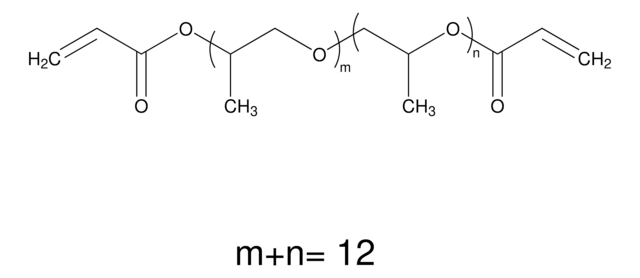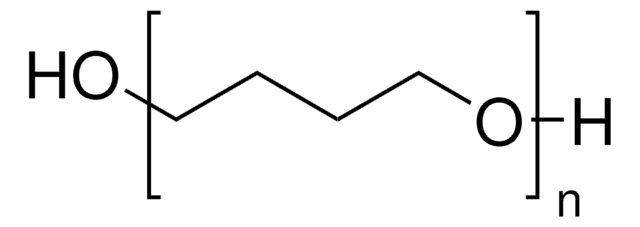Kluczowe dokumenty
202312
Poly(propylene glycol)
average Mn ~725
Synonim(y):
PPG, Poly(propylene oxide)
About This Item
Polecane produkty
gęstość pary
>1 (vs air)
Poziom jakości
ciśnienie pary
<0.01 mmHg ( 20 °C)
masa cząsteczkowa
average Mn ~725
zawiera
130-190 ppm proprietary phenolic antioxidant
współczynnik refrakcji
n20/D 1.449
lepkość
115 cSt(25 °C)(lit.)
wartość hydroksylowa
147 mg KOH/g
rozpuszczalność
water: miscible (completely)
gęstość
1.007 g/mL at 25 °C
ciąg SMILES
CC(O)CO
InChI
1S/C6H14O3/c1-5(8)4-9-6(2)3-7/h5-8H,3-4H2,1-2H3
Klucz InChI
DUFKCOQISQKSAV-UHFFFAOYSA-N
Szukasz podobnych produktów? Odwiedź Przewodnik dotyczący porównywania produktów
Powiązane kategorie
Zastosowanie
- Recycling of waste materials: Utilization of propylene glycol in the recycling of waste poly(vinyl chloride) to enhance the mechanical properties of new polymer composites (Hilary et al., 2021).
- Dental composite improvement: Enhancement of dental composites′ conversion rates through the use of poly(propylene glycol) and urethane dimethacrylates, while also examining cytocompatibility (Walters et al., 2016).
- 3D printing of scaffolds: Use of poly(propylene fumarate) and propylene glycol in 3D printing of resorbable tissue engineering scaffolds, demonstrating innovation in medical applications (Childers et al., 2015).
Kod klasy składowania
10 - Combustible liquids
Klasa zagrożenia wodnego (WGK)
WGK 1
Temperatura zapłonu (°F)
445.0 °F - closed cup
Temperatura zapłonu (°C)
229.44 °C - closed cup
Środki ochrony indywidualnej
Eyeshields, Gloves
Wybierz jedną z najnowszych wersji:
Masz już ten produkt?
Dokumenty związane z niedawno zakupionymi produktami zostały zamieszczone w Bibliotece dokumentów.
Klienci oglądali również te produkty
Nasz zespół naukowców ma doświadczenie we wszystkich obszarach badań, w tym w naukach przyrodniczych, materiałoznawstwie, syntezie chemicznej, chromatografii, analityce i wielu innych dziedzinach.
Skontaktuj się z zespołem ds. pomocy technicznej





